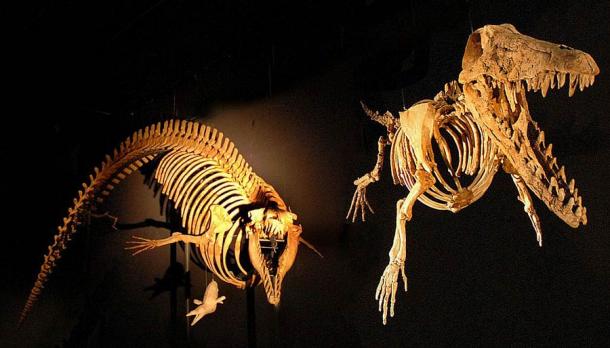
Four-Legged Whale Found in Egypt Named after Egyptian God Anubis
Egyptian paleontologists have identified a new four-legged whale species that walked on land more than 43 million years ago. The fossilized partial skeleton of this exotic creature was discovered in Egypt, west of the Nile, in 2008. After 13 years of intensive study, the paleontologists have concluded that this particular walking whale was unique to the African region. They’ve named this fierce four-legged whale predator Phiomicetus anubis, in honor of the ancient Egyptian god of the dead, Anubis.
Egypt’s Amazing Four-Legged Whale Fossil Find
The incredible four-legged whale fossil find was unearthed from a layer of rocks in the Fayum Depression, a fossil-rich area in Egypt’s Western Desert. The fossil was dug out of a layer of rocks that dates to the middle Eocene geological epoch, which covered the period from 48 million to 38 million years ago. At that time what is now Egyptian desert was mostly covered by a vast sea, and the whale skeleton would have been preserved originally in an area along the coast of that sea.
After its discovery, the ancient four-legged whale skeleton was taken to the Mansoura University Vertebrate Paleontology Center (MUVP) for further study. Following 13 years of analysis, the Egyptian paleontologists who studied the skeleton were finally ready to announce in an article published by The Royal Society that their four-legged whale belonged to a species that had never before been seen in the Eocene fossil record.
- Titanoboa: The Monster Snake that Ruled Prehistoric Colombia
- California Park Ranger Discovers Massive Cache of Miocene Epoch Fossils
It should be noted that this is not the first four-legged whale skeleton to be recovered during paleontological excavations. In fact, several such specimens have been found, all of which belong to a group of extinct whales known as the protocetids.
But P. anubis represents a whole new species, with relatively primitive characteristics that identify it as the oldest semi-aquatic whale species ever found in Africa.

A map detailing the Fayum Depression in Egypt, where paleontologists found the four-legged whale fossil. (Gohar A.S. et al / Biological Sciences)
The New Four-legged Whale Species: An Extraordinary Predator
When fully grown, P. anubis would have been about 10 feet (three meters) long and would have weighed approximately 1,300 pounds (590 kilograms). This is not large by modern whale standards, but what this whale lacked in size it made up for in flexibility, strength, and ferocity.
It could swim as easily as it could walk, allowing it to move back and forth between land and water in search of prey. With its gaping mouth and powerful jaw muscles, it could grab, crush, and quickly consume crocodiles, smaller mammals, and even whale calves from other whale species.
In giving this species the name P. anubis, the Egyptian paleontologists were inspired by the shape of its head. It bore a striking resemblance to the skull of the jackal-headed god Anubis, whose frightening appearance symbolized impending death.
From the standpoint of its unfortunate prey, the appearance of P. anubis also meant the end was near.
"It was a successful, active predator," study lead author Abdullah Gohar, a graduate student of vertebrate paleontology at Mansoura University in Egypt, told Live Science. "I think it was the god of death for most animals that lived alongside it."

Paleontologists working in the Fayum Depression in Egypt, where paleontologists found the four-legged whale fossil. (MUVP)
From the Land to the Sea, and Everything in Between
Whales are now the largest of all sea creatures. But they were once something quite different.
“Over about 10 million years, the ancestors of whales transformed from herbivorous, deer-like, terrestrial mammals into carnivorous and fully aquatic cetaceans,” the study authors wrote, in the new article published in the Proceedings of the Royal Society B: Biological Sciences. “Protocetids are Eocene whales that represent a unique semiaquatic stage in that dramatic evolutionary transformation.”
The first true protocetid whales are believed to have appeared in South Asia approximately 50 million years ago. Over the course of time, the protocetids traveled far and wide on the earth’s oceans, ranging as far as any modern whale species.
In 2019, a team of paleontologists working in South America announced the discovery of a 43-million-year-old fossilized four-legged whale skeleton that had been found along the Pacific shoreline of Peru. This fossil was actually unearthed in 2011, or three years after P. anubis. But it took longer to establish that the latter was a truly unique member of the protocetid family.
Interestingly, P. anubis isn’t the only ancient whale species to be discovered in middle Eocene-level excavations in the Western Egyptian desert. Not far from where the bones of P. anubis were found, paleontologists recovered the ancient skeletal remains of a type of fully aquatic whale known as Rayanistes afer. It seems the two Eocene species lived side-by-side in the same ecosystem, while occupying different niches in the complex coastal food chain.
This type of whale also possessed the anatomy of a creature that could live on both the land and the sea. But in comparison to P. anubis, it seems Rayanistes afer had progressed somewhat farther along the evolutionary timescale, abandoning its amphibious ways to take up full-time residence in the ocean. This makes Rayanistes afer a more obvious forerunner of the modern whale.

Archaeocete (whale predecessor) skeletons. On the right is Ambulocetus natans ("the walking whale that swims"), on the left is Cynthiacetus, a fully aquatic cetacean with small hind limbs. Image from the exhibit "Incroyables Cétacées" in Grande Galerie de l'Evolution at National Museum of Natural History in Paris, France. (Jean-Pierre Dalbéra / CC BY 2.0)
A Whale of an Evolutionary Tale
The study of whale evolution in the oceans and along the shorelines of Africa is still in its preliminary stages, the Egyptian paleontologists say. But they note that the evolutionary transition that took whales from amphibious to permanently aquatic appears to be on full display in the fossil record in the Fayum Depression, where 12 million years of geological history are available for further exploration and study.
- This Tiny Predator Existed Alongside the Giant Dinosaurs
- Dinosaur in Mexico: New “Talking” Species Used Low Frequency Sounds
And the discovery of the P. anubis skeleton undoubtedly represents an important milestone.
“Phiomicetus anubis is a key new whale species, and a critical discovery for Egyptian and African paleontology," Abdullah Gohar told the Reuters news agency.
While this one ancient skeleton can’t answer every question, it will certainly help paleontologists fill in some of the blanks in a complex and endlessly fascinating evolutionary story.
Top image: The Anubis four-legged whale as depicted by palaeontologist Robert W. Boessenecker, a professor at the College of Charleston, Charleston, South Carolina, USA. Source: Robert W. Boessenecker / College of Charleston
By Nathan Falde















